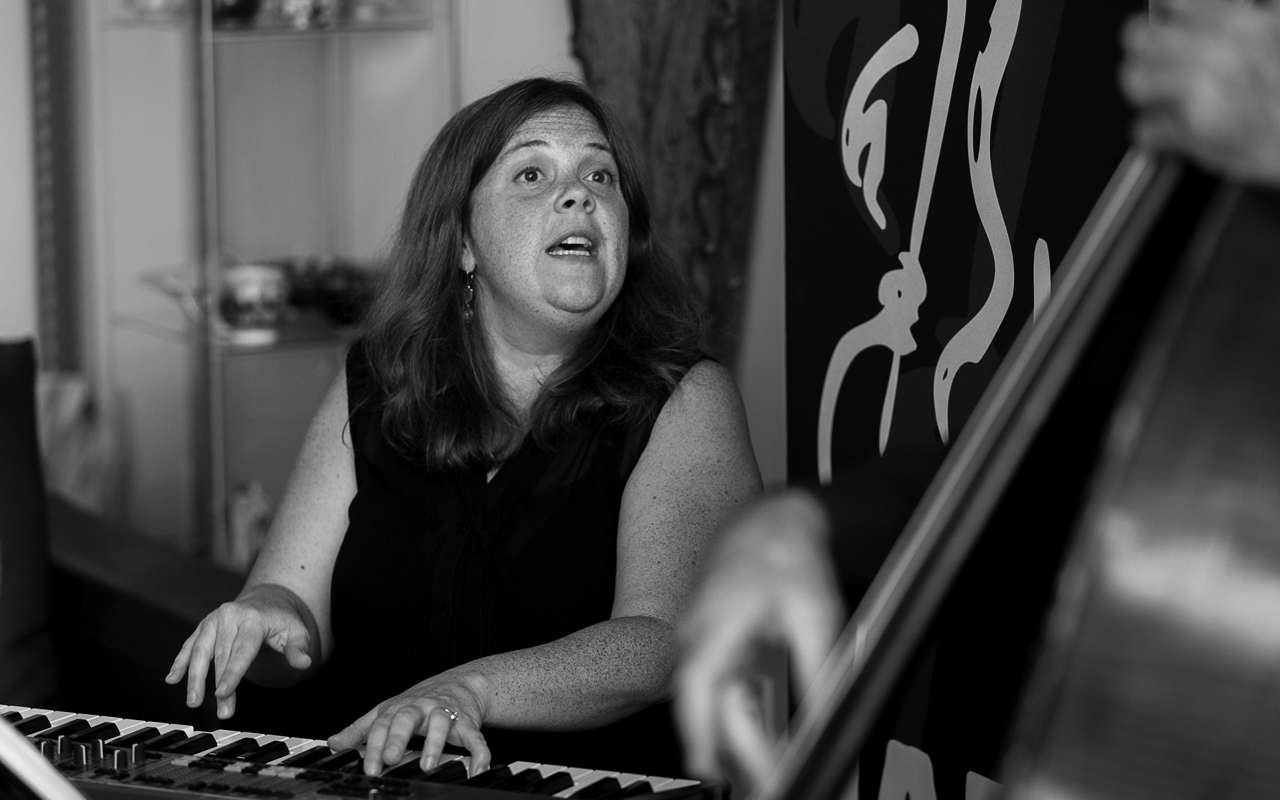
Dawn Clement photo by Daniel Sheehan.
By Mayumi Tsutakawa
The designation of “resident artist” for the annual Earshot Jazz Festival is meant to highlight an artist who has made outstanding contributions to the overall jazz ecology here in the Puget Sound area. This year, well over 60% of the individual artists in this year’s festival live in the Seattle area, and as 2017 Resident Artist, Dawn Clement stands out mightily here as a multi-talented composer, performer and vocalist.
Festival-wise, Clement will perform in several concerts in a series of duo performances she devised with a wide range of musicians—some from Seattle, some from New York City. Also, following a standing-ovation solo performance of Thelonious Monk music at the 2014 Earshot Jazz Festival, she has been chosen to present 10 solo Monk pieces for his birthday tribute concert on October 10 at the Seattle Art Museum. And, if that were not enough productivity, Earshot has invited Clement to present a concert of her own work on November 11 at Cornish College, where she is adjunct instructor of piano.
Clement is a winner of three Golden Ear Awards from Earshot voters in recent years, for best performance and outstanding artist (twice), among other prestigious awards. She has completed five albums and is called upon to teach at institutes across the nation (for more information, see dawnclement.com). Earshot Jazz met with the acclaimed artist to discuss her background and her perspectives on jazz today.
Earshot Jazz: In your music training, what was the most important thing that led you to the creative work that you are doing today?
Dawn Clement: I started classical piano at 10 and started playing jazz in high school. I got a Cornish scholarship for jazz performance and completed my degree in 2000. And I just finished my master’s in composition at Vermont College of Fine Arts. My Cornish faculty and Vermont faculty were so inspiring to me and I have performed with many of them.
My teachers taught me to be disciplined, and how to practice, and I have built relationships with them along the way. I have learned a lot from Julian Priester, Jane Ira Bloom, and I learn from students and colleagues alike. The most important thing is that there is not one thing that is most important. It is the journey and the many things you encounter that are important.
EJ: Do you enjoy teaching, and what do you think of today’s jazz music students?
DC: In 2000 after I graduated I joined the faculty at Cornish. Teaching the piano lab class, I enjoy my students and try to reinvent the class as I go. I also teach private students, combos, high school groups, and junior high school level, too.
Jazz students are different today, compared to when I was one. Many are very dedicated and I love their music, which shows they are interested in a lot of different things. They are not just focused on listening to, and playing, jazz in one way. They have shown me music styles that are taking it to the next step.
Some are more original and closer to music on the streets. It’s such a digital world now and they have different skills and interests than I did, for example some students can make their own records now.
EJ: Do you enjoy solo work/performance? Or do you prefer ensemble work/performance? Why, and what do you look for in ensemble partners?
DC: I like both solo and ensemble work. Solo work is vulnerable work where I stick out my hand to the audience and communicate with people.
I also like to play with others, and improvise with people. It keeps us all honest and in real time. The music is conversational. It involves our reaction time and skills and personalities. A bandleader I once worked with liked that the ensemble people were all from different backgrounds but found a similar reference point. What I look for are players who listen deeply and are generous, forgiving in the moment, and have a sense of humor.
I also get to put my things aside when I play as a side man. I play here in town with my quartet, and also with Julian Priester, when he plays here. I am playing in New York about three times a year. And other out-of-town places, too. My family includes three kids so I’m lucky to have a great husband who helps out.
EJ: What is the legacy of Thelonious Monk today? How is his influence felt?
DC: The first jazz tune I ever learned was Monk. I have been playing Monk since the beginning. Obviously, the Thelonious Monk Institute of Jazz and the Monk competition continue his legacy. His legacy comes from the fact that his music is so accessible, everyone can identify with it. Why? Because of the ways his melodies and solos are so strong. The tunes get repeated, like in the blues. Playing his music, I am not an expert but I find new things to bring to it. It makes sense that his music is still performed on his 100th birthday.
EJ: What is the importance and direction of jazz today?
DC: I think it has the same importance it always has had. It involves improvisation, what is not written on the page. Some say it’s getting diluted, trickling into other areas of music. Various artists are figuring ways to search out new forms. In the ‘60s, ‘70, and ‘80s, each decade there were certain trends in jazz. But now there is not one way of doing that, it is more fragmented and directionless, but not in a bad way.
Dawn Clement at the Earshot Jazz Festival
October 10, Seattle Art Museum – Theolonious Monk Birthday Celebration
October 17, PONCHO Concert Hall – Dawn Duos (with Naomi Moon Siegel Band)
October 24, Chapel Performance Space– Dawn Duos (with Matt Mitchell)
November 11, PONCHO Concert Hall – LineUp!
Full festival info at earshot.org